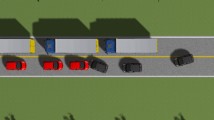Summary
Authentic car-to-car side collisions (n = 30) with the main impact area at the B-pillar were analyzed to find technical parameters corresponding with the injury severities of the front seat, belt-protected car passengers on the impact side. EES (Energy Equivalent Speed) and Av (delta v, change in velocity) were highly significant predictors of the severity of thoracic and abdominal injuries and total injury severity coded according to the Abbreviated Injury Scale (AIS). At an EES or Δ v ≥ 40 km/h all front-seat car passengers on the impact side sustained a total injury severity of Maximum AIS (MAIS) ≥ 4 and died. Although a passenger could survive the crash without injury to one or more body regions up to the highest EES- and Av-values, at EES or Δ v ≥ 40 km/h fatal injuries were sustained in at least one body region. At an EES ≥ 35 km/h or a Av ≥ 15 km/h no front-seat car passenger on the impact side remained uninjured.
Zusammenfassung
30 reale Pkw-Pkw-Seitenkollisionen mit Hauptanstoßpunkt B-Holm and stoßnah sitzenden angegurteten Frontinsassen wurden mit forensischer Genauigkeit rekonstruiert and die technischen Parameter mit der Verletzungsschwere, codiert nach AIS (Abbreviated Injury Scale) 1985, in Beziehung gesetzt. EES (Energy Equivalent Speed) and Geschwindkeitsänderung Δv waren hochsignifikante Prädiktoren der Thorax-, Abdominal- and Gesamtverletzungsschwere. Ab einer EES oder Δ v ≥ 40 km/h erlitten die stoßnahen Insassen eine Gesamtverletzungsschwere MAIS ≥ 4 and starben. Auch wenn Insassen bis zu höchstens EES- oder Av-Werten in einer oder mehreren Körperregionen unverletzt bleiben konnten, erlitten sie ab einer EES oder Av≥40 km/h tödliche Verletzungen in mindestens einer Körperregion. Ab einer EES ≥ 35 km/h oder einer Av ≥ 25 km/h blieb kein stoßnaher Insasse mehr unverletzt.
Similar content being viewed by others
References
Burg H (1973) Das Antriebs-Balance-Diagramm als optimales Mittel der Unfallanalyse. Der Verkehrsunfall, Verlag Information Ambs GmbH, Kippenheim, Issue 2
Burg H, Rau H (1981) Handbuch der Verkehrsunfallrekonstruktion. Verlag Information Ambs GmbH, Kippenheim
Burg H, Zeidler F (1980) EES - ein Hilfsmittel zur Unfallrekonstruktion und dessen Auswirkungen auf die Unfallforschung. Der Verkehrsunfall, Verlag Information Ambs GmbH, Kippenheim, Issue 4
Daimler Benz (1988) Pressemappe zum Workshop aktive and passive Sicherheit. Presseabteilung Daimler-Benz AG, Stuttgart
Danner M, Langwieder K, Hummel TH (1987) Experience from the analyses of accidents with a high belt usage rate and aspects of continued increase in passenger safety. 11th Int Techn Conf on Exp Safety Vehicles, Washington, 12.-15.5. 1987, pp 201–210
Evans L (1985) Fatality risk for belted drivers versus car mass. Accid Anal Prev 17:251–271
Evans L (1985) Involvement rate in two-car crashes versus driver age and car mass of each involved car. Accid Anal Prev 16:387–405
Evans L, Wasielewski P (1987) Serious or fatal driver injury rate versus car mass in head-on crashes between cars of similar mass. Accid Anal Prev 19:119–131
Glaeser KP (1982) Über die Problematik von Pkw-Pkw-Unfdllen zwischen großen und kleinen Fahrzeugen. Z Verkehrssicherheit 28:23–28
Kallieris D, Mattern R, Hardle W (1986) Belastbarkeitsgrenzen und Verletzungsmechanik der angegurteten Fahrzeuginsassen beim Seitaufprall (2) Schriftenreihe Forschungsvereinigung Automobiltechnik eV, Frankfurt, Nr. 60
Mattern R, Barz J, Schulz F, Kallieris D, Schmidt G (1979) Problems arising when using injury scales in the biomechanical investigation with special consideration of the age influence. Conf Proc 4th IRCOBI, Göteborg, 5.-7.9.1979, pp 223–231
Niederer P, Walz F, Weissner R (1980) Verletzungsursachen beim Pkw-Insassen. Verletzungsminderung durch moderne Sicherheitseinrichtungen. Unfallheilkunde 83:326–340
Otte D, Kühnel A, Suren EG, Weber H, Gotzen L, Schockenhoff G, Vu Han V (1982) Erhebungen am Unfallort, Unfallund Sicherheitsforschung Straßenverkehr 37, Herausgegeben von der Bundesanstalt fur Straßenwesen. Bereich Unfallforschung, Köln, pp 1–100
Otte D (1990) Comparison and realism of crash simulation tests and real Accident situations for the biomechanical movements in car collisions. Conf Proc 34th Stapp, Orlando, Florida, 4.7.11. 1990, pp 329–347
Robertson LS, Baker SP (1976) Motor vehicle sizes in 1440 fatal crashes. Accid Anal Prev 8:167–175
Ropohl D (1990) Die rechtsmedizinische Rekonstruktion von Verkehrsunfallen. DAT-Schriftenreihe Technik, Markt, Sachverständigenwesen, vol 5:90–92
Rouhana SW, Forster ME (1985) Lateral impact - An analyses of the statistics in the BCSS. Conf Proc 29th Stapp., Washington, 9–11.10.1985, pp 79–98
Slibar A (1986) Die mechanischen Grundsätze des Stoßvorganges und ihre Anwendung. Archiv für Unfallforschung, GUFU Baden-Baden
Schmidt G (1979) The age as a factor influencing soft tissue injuries. Conf Proc 4th IRCOBI, Göteborg, 5.-7.9.1979, pp 143-150
States JD, Huelke DF, Baker SP, Bryant RW et al. (1980) The abbreviated injury scale (AIS), 1985 Revision, American Association for Automative Medicine (ARAM)
Author information
Authors and Affiliations
Rights and permissions
About this article
Cite this article
Miltner, E., Wiedmann, H.P., Leutwein, B. et al. Technical parameters influencing the severity of injury of front-seat, belt-protected car passengers on the impact side in car-to-car side collisions with the main impact between the front and rear seats (B-pillars). Int J Leg Med 105, 11–15 (1992). https://doi.org/10.1007/BF01371230
Received:
Revised:
Issue Date:
DOI: https://doi.org/10.1007/BF01371230




